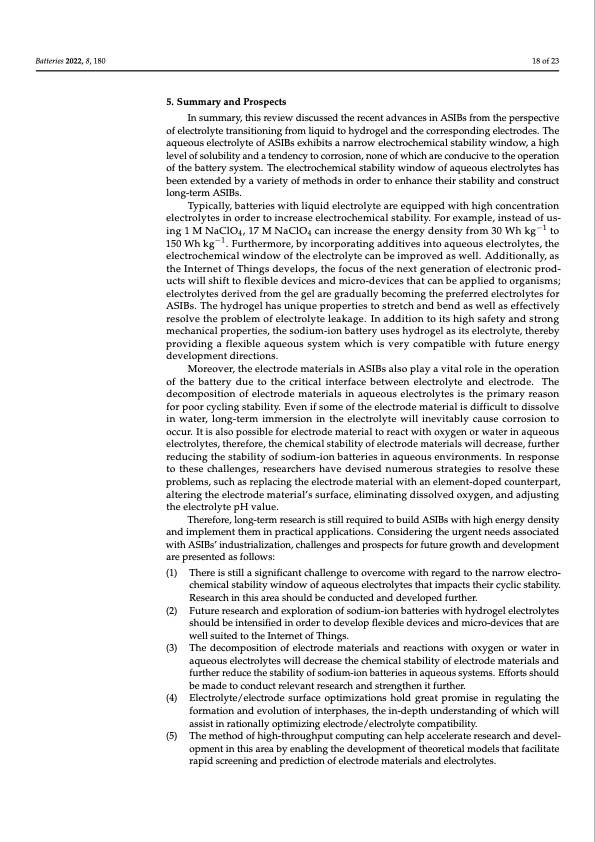
PDF Publication Title:
Text from PDF Page: 018
Batteries 2022, 8, 180 18 of 23 5. Summary and Prospects In summary, this review discussed the recent advances in ASIBs from the perspective of electrolyte transitioning from liquid to hydrogel and the corresponding electrodes. The aqueous electrolyte of ASIBs exhibits a narrow electrochemical stability window, a high level of solubility and a tendency to corrosion, none of which are conducive to the operation of the battery system. The electrochemical stability window of aqueous electrolytes has been extended by a variety of methods in order to enhance their stability and construct long-term ASIBs. Typically, batteries with liquid electrolyte are equipped with high concentration electrolytes in order to increase electrochemical stability. For example, instead of us- ing 1 M NaClO4, 17 M NaClO4 can increase the energy density from 30 Wh kg−1 to 150 Wh kg−1. Furthermore, by incorporating additives into aqueous electrolytes, the electrochemical window of the electrolyte can be improved as well. Additionally, as the Internet of Things develops, the focus of the next generation of electronic prod- ucts will shift to flexible devices and micro-devices that can be applied to organisms; electrolytes derived from the gel are gradually becoming the preferred electrolytes for ASIBs. The hydrogel has unique properties to stretch and bend as well as effectively resolve the problem of electrolyte leakage. In addition to its high safety and strong mechanical properties, the sodium-ion battery uses hydrogel as its electrolyte, thereby providing a flexible aqueous system which is very compatible with future energy development directions. Moreover, the electrode materials in ASIBs also play a vital role in the operation of the battery due to the critical interface between electrolyte and electrode. The decomposition of electrode materials in aqueous electrolytes is the primary reason for poor cycling stability. Even if some of the electrode material is difficult to dissolve in water, long-term immersion in the electrolyte will inevitably cause corrosion to occur. It is also possible for electrode material to react with oxygen or water in aqueous electrolytes, therefore, the chemical stability of electrode materials will decrease, further reducing the stability of sodium-ion batteries in aqueous environments. In response to these challenges, researchers have devised numerous strategies to resolve these problems, such as replacing the electrode material with an element-doped counterpart, altering the electrode material’s surface, eliminating dissolved oxygen, and adjusting the electrolyte pH value. Therefore, long-term research is still required to build ASIBs with high energy density and implement them in practical applications. Considering the urgent needs associated with ASIBs’ industrialization, challenges and prospects for future growth and development are presented as follows: (1) There is still a significant challenge to overcome with regard to the narrow electro- chemical stability window of aqueous electrolytes that impacts their cyclic stability. Research in this area should be conducted and developed further. (2) Future research and exploration of sodium-ion batteries with hydrogel electrolytes should be intensified in order to develop flexible devices and micro-devices that are well suited to the Internet of Things. (3) The decomposition of electrode materials and reactions with oxygen or water in aqueous electrolytes will decrease the chemical stability of electrode materials and further reduce the stability of sodium-ion batteries in aqueous systems. Efforts should be made to conduct relevant research and strengthen it further. (4) Electrolyte/electrode surface optimizations hold great promise in regulating the formation and evolution of interphases, the in-depth understanding of which will assist in rationally optimizing electrode/electrolyte compatibility. (5) The method of high-throughput computing can help accelerate research and devel- opment in this area by enabling the development of theoretical models that facilitate rapid screening and prediction of electrode materials and electrolytes.PDF Image | Aqueous Rechargeable Sodium-Ion Batteries Hydrogel

PDF Search Title:
Aqueous Rechargeable Sodium-Ion Batteries HydrogelOriginal File Name Searched:
batteries-08-00180-v2.pdfDIY PDF Search: Google It | Yahoo | Bing
Salgenx Redox Flow Battery Technology: Salt water flow battery technology with low cost and great energy density that can be used for power storage and thermal storage. Let us de-risk your production using our license. Our aqueous flow battery is less cost than Tesla Megapack and available faster. Redox flow battery. No membrane needed like with Vanadium, or Bromine. Salgenx flow battery
| CONTACT TEL: 608-238-6001 Email: greg@salgenx.com | RSS | AMP |